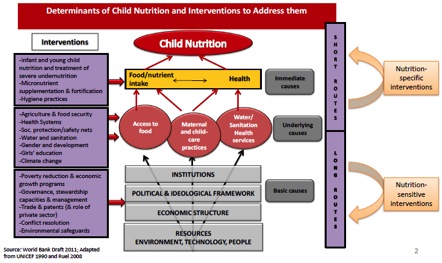|
![]()
| 2. Determinants of maternal and child under nutrition What1 #263731 The determinants of malnutrition are multidimensional and interrelated, ranging from factors as broad as political instability and weak economic growth, to those as specific as poor diet, respiratory infection, diarrheal disease, age of the child, and the mother’s education and wealth status. | - Hence, the proposed solutions vary from measures to improve the stability and economic performance of countries and to enhancing access to sanitation and health services in individual communities.
- There are very many direct and indirect drivers that influence these direct drivers in turn. Interventions that target malnutrition reduction as a goal must review which drivers or behaviours most influence it in a particular context.
UNICEF Conceptual Framework Figure 7: Conceptual framework of basic, underlying and immediate causes of child under nutrition 
The well-known UNICEF conceptual framework (above) demonstrates the relationships among the determinants of under nutrition. It also shows the possible interventions to tackle child under nutrition. - In the top box of interventions that relate to immediate causes of child under nutrition, are the direct nutrition-specific interventions to be undertaken to tackle the immediate causes of child under nutrition: in the case of WINNN, these are CMAM, IYCF, micro-nutrient supplementation, and health interventions including deworming. In this area of tackling the immediate causes of child under nutrition, the cause-effect linkages are short and much is well known about what works.
- In the middle box are some of the indirect nutrition-sensitive interventions to tackle the determinants of child under nutrition: social protection programmes which aim to improve household income and reduce food insecurity; initiatives to build links and leverage synergies between nutrition and agriculture sector programmes and policies; strategies to promote gender equality and women’s empowerment; programmes to improve access to improved water and sanitation; and initiatives to explore the roles of civil society and the private sector in demanding and supplying high quality scaled-up health and nutrition services. Here the cause-effect linkages are longer with a theory of change more complicated, but understanding of what works is being generated.
- The bottom box relates to basic causes that relate to institutional governance, and political and social systems, as well as the natural resource base and the economic structure of the location. Programmes and policies that can have an effect at this level include poverty reduction, trade, conflict resolution, political engagement, and good governance and coordination of nutrition-related programmes and sectors. Policies and programmes that address the basic causes of child under nutrition are very important but the linkages that do so are lengthy and not well understood.
As the conceptual framework suggests, there are very many complex pathways among these variables; therefore it is important to articulate a theory of change to begin to illuminate these pathways in any given context. Interventions to reduce malnutrition must assess the underlying determinants (at immediate, underlying and basic cause levels) specific to the context, building on existing research and the knowledge of key stakeholders (government officials, research workers, nutritionists, and agriculture, social care and health professionals). The existing studies that exist on pathways are mostly cross-section analyses of varying strength. The weaknesses of such studies are: - they do not show causal relationships, only associations
- such relationships are easily confounded as the causal pathways are rarely direct
- they do not include “explanatory” variables sufficiently specific to support pilot design
- the studies are not sufficiently context specific.
But such studies give valuable insights to be built upon for future research. In addition they were not carried out with any direct relationship to this conceptual framework. |
|
|